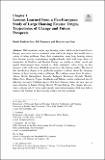Files in this item
Lessons learned from a pan-European study of large housing estates : origin, trajectories of change and future prospects
Item metadata
| dc.contributor.author | Hess, Daniel Baldwin | |
| dc.contributor.author | Tammaru, Tiit | |
| dc.contributor.author | van Ham, Maarten | |
| dc.date.accessioned | 2019-02-13T13:30:05Z | |
| dc.date.available | 2019-02-13T13:30:05Z | |
| dc.date.issued | 2018-08-15 | |
| dc.identifier | 257732113 | |
| dc.identifier | 24394310-c2f1-4106-b8ec-85b5a38990b1 | |
| dc.identifier | 85060728389 | |
| dc.identifier | 000457312600002 | |
| dc.identifier.citation | Hess , D B , Tammaru , T & van Ham , M 2018 , Lessons learned from a pan-European study of large housing estates : origin, trajectories of change and future prospects . in Urban book series . Urban book series , Springer , Cham , pp. 3-31 . https://doi.org/10.1007/978-3-319-92813-5_1 | en |
| dc.identifier.issn | 2365-757X | |
| dc.identifier.other | ORCID: /0000-0002-2106-0702/work/64697583 | |
| dc.identifier.uri | https://hdl.handle.net/10023/17054 | |
| dc.description | The research leading to this work has received funding from the European Union’s Horizon 2020 research and innovation programme under Marie Skłodowska-Curie grant agreement number 655601. Support also came from three grants from the Estonian Research Council: Institutional Research Grant IUT2-17 on Spatial Population Mobility and Geographical Changes in Urban Regions, Infotechnological Mobility Observatory, and RITA-Ränne. The European Research Council funded this research under the European Union’s Seventh Framework Programme (FP/2007-2013)/ERC [Grant Agreement No. 615159] (ERC Consolidator Grant DEPRIVEDHOODS, Socio-spatial inequality, deprived neighbourhoods, and neighbourhood effects). | en |
| dc.description.abstract | Mid-twentieth-century large housing estates, which can be found all over Europe, were once seen as modernist urban and social utopias that would solve a variety of urban problems. Since their construction, many large housing estates have become poverty concentrating neighbourhoods, often with large shares of immigrants. In Northern and Western Europe, an overlap of ethnic, social and spatial disadvantages have formed as ethnic minorities, often living on low incomes, settle in the most affordable segments of the housing market. The aim of this introductory chapter is to synthesise empirical evidence about the changing fortunes of large housing estates in Europe. The evidence comes from 14 cities—Athens, Berlin, Birmingham, Brussels, Budapest, Bucharest, Helsinki, Madrid, Milan, Paris, Moscow, Prague, Stockholm and Tallinn—and is synthesised into 10 takeaway messages. Findings suggest that large housing estates are now seen as more attractive in Eastern Europe than in Western Europe. The chapter also provides a diverse set of visions and concrete intervention measures that may help to improve the fortunes of large housing estates and their residents. | |
| dc.format.extent | 29 | |
| dc.format.extent | 627441 | |
| dc.language.iso | eng | |
| dc.publisher | Springer | |
| dc.relation.ispartof | Urban book series | en |
| dc.relation.ispartofseries | Urban book series | en |
| dc.subject | European cities | en |
| dc.subject | Housing estates | en |
| dc.subject | Neighbourhood planning | en |
| dc.subject | Residential planning | en |
| dc.subject | Urban change | en |
| dc.subject | G Geography (General) | en |
| dc.subject | Urban Studies | en |
| dc.subject | Geography, Planning and Development | en |
| dc.subject | SDG 11 - Sustainable Cities and Communities | en |
| dc.subject.lcc | G1 | en |
| dc.title | Lessons learned from a pan-European study of large housing estates : origin, trajectories of change and future prospects | en |
| dc.type | Book item | en |
| dc.contributor.sponsor | European Research Council | en |
| dc.contributor.institution | University of St Andrews. School of Geography & Sustainable Development | en |
| dc.identifier.doi | 10.1007/978-3-319-92813-5_1 | |
| dc.identifier.grantnumber | ERC-2013-CoG | en |
This item appears in the following Collection(s)
Items in the St Andrews Research Repository are protected by copyright, with all rights reserved, unless otherwise indicated.

